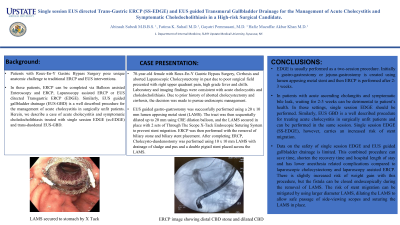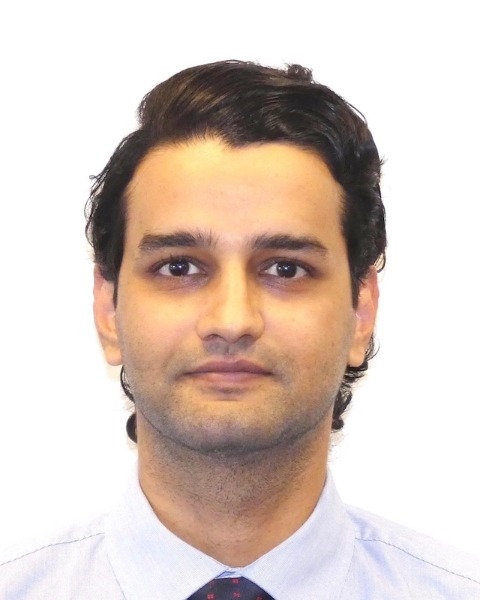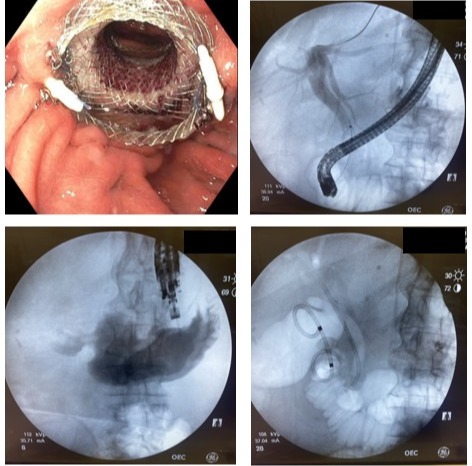Monday Poster Session
Category: Interventional Endoscopy
P2332 - Single Session EUS Directed Trans-Gastric ERCP (SS-EDGE) and EUS Guided Transmural Gallbladder Drainage for the Management of Acute Cholecystitis and Symptomatic Choledocholithiasis in a High-Risk Surgical Candidate
Monday, October 23, 2023
10:30 AM - 4:15 PM PT
Location: Exhibit Hall

Has Audio

Abinash Subedi, MBBS
SUNY Upstate Medical University
Syracuse, NY
Presenting Author(s)
Abinash Subedi, MBBS1, Fathima Keshia Suhail, MD1, Gayatri Pemmasani, MBBS2, Hafiz M. Khan, MD1
1SUNY Upstate Medical University, Syracuse, NY; 2Upstate University Hospital, Syracuse, NY
Introduction: Patients with Roux-En-Y Gastric Bypass Surgery pose unique anatomic challenge to traditional ERCP and EUS interventions. Herein, we describe a unique case of acute cholecystitis and symptomatic choledocholithiasis treated with same session EDGE and trans-duodenal EUS-GBD.
Case Description/Methods: 70-year-old female with Roux-En-Y Gastric Bypass Surgery, Cirrhosis presented with right upper quadrant pain, high grade fever and chills. Laboratory analysis showed leukocytosis with left shift and liver enzyme elevation in obstructive pattern. MRCP revealed a 12 mm CBD stone and gallstones with wall thickening and pericholecystic fluid suggestive of acute cholecystitis. After discussion with surgery, due to prior history of aborted cholecystectomy for difficult surgical field and cirrhosis, the decision was made to pursue endoscopic management.
EUS guided gastro-gastrostomy was successfully performed using a 20 x 10 mm lumen apposing metal stent (LAMS). The tract was then sequentially dilated up to 20 mm using CRE dilation balloon, and the LAMS secured in place with 2 sets of Through the scope X-Tack Endoscopic Suturing System to prevent stent migration. ERCP was then performed with the removal of biliary stone and biliary stent placement. After completing ERCP, Cholecysto-duodenostomy was performed using 10 x 10 mm LAMS with drainage of sludge and pus and a double pigtail stent placed across the LAMS.
Discussion: EDGE has shown promising results and is safe in patients at high risk for surgical management. It is usually performed as a two-session procedure. Initially a gastro-gastrostomy or jejuno-gastrostomy is created using LAMS and then ERCP is performed after 2-3 weeks to allow tract maturation and prevent stent migration.
In patients with ascending cholangitis and symptomatic bile leak, waiting for 2-3 weeks can be detrimental to patient’s health. In these settings, single session EDGE should be performed. Similarly, EUS GBD is a well described procedure for treating acute cholecystitis in surgically unfit patients.
Data on the safety of single session EDGE and EUS guided gallbladder drainage is limited. This combined procedure can save time, shorten the recovery time, and has lower anesthetic complications compared to laparoscopic cholecystectomy and laparoscopy assisted ERCP. The risk of stent migration can be mitigated by using larger diameter LAMS, dilating the LAMS to allow safe passage of side-viewing scopes and suturing the LAMS in place.

Disclosures:
Abinash Subedi, MBBS1, Fathima Keshia Suhail, MD1, Gayatri Pemmasani, MBBS2, Hafiz M. Khan, MD1. P2332 - Single Session EUS Directed Trans-Gastric ERCP (SS-EDGE) and EUS Guided Transmural Gallbladder Drainage for the Management of Acute Cholecystitis and Symptomatic Choledocholithiasis in a High-Risk Surgical Candidate, ACG 2023 Annual Scientific Meeting Abstracts. Vancouver, BC, Canada: American College of Gastroenterology.
1SUNY Upstate Medical University, Syracuse, NY; 2Upstate University Hospital, Syracuse, NY
Introduction: Patients with Roux-En-Y Gastric Bypass Surgery pose unique anatomic challenge to traditional ERCP and EUS interventions. Herein, we describe a unique case of acute cholecystitis and symptomatic choledocholithiasis treated with same session EDGE and trans-duodenal EUS-GBD.
Case Description/Methods: 70-year-old female with Roux-En-Y Gastric Bypass Surgery, Cirrhosis presented with right upper quadrant pain, high grade fever and chills. Laboratory analysis showed leukocytosis with left shift and liver enzyme elevation in obstructive pattern. MRCP revealed a 12 mm CBD stone and gallstones with wall thickening and pericholecystic fluid suggestive of acute cholecystitis. After discussion with surgery, due to prior history of aborted cholecystectomy for difficult surgical field and cirrhosis, the decision was made to pursue endoscopic management.
EUS guided gastro-gastrostomy was successfully performed using a 20 x 10 mm lumen apposing metal stent (LAMS). The tract was then sequentially dilated up to 20 mm using CRE dilation balloon, and the LAMS secured in place with 2 sets of Through the scope X-Tack Endoscopic Suturing System to prevent stent migration. ERCP was then performed with the removal of biliary stone and biliary stent placement. After completing ERCP, Cholecysto-duodenostomy was performed using 10 x 10 mm LAMS with drainage of sludge and pus and a double pigtail stent placed across the LAMS.
Discussion: EDGE has shown promising results and is safe in patients at high risk for surgical management. It is usually performed as a two-session procedure. Initially a gastro-gastrostomy or jejuno-gastrostomy is created using LAMS and then ERCP is performed after 2-3 weeks to allow tract maturation and prevent stent migration.
In patients with ascending cholangitis and symptomatic bile leak, waiting for 2-3 weeks can be detrimental to patient’s health. In these settings, single session EDGE should be performed. Similarly, EUS GBD is a well described procedure for treating acute cholecystitis in surgically unfit patients.
Data on the safety of single session EDGE and EUS guided gallbladder drainage is limited. This combined procedure can save time, shorten the recovery time, and has lower anesthetic complications compared to laparoscopic cholecystectomy and laparoscopy assisted ERCP. The risk of stent migration can be mitigated by using larger diameter LAMS, dilating the LAMS to allow safe passage of side-viewing scopes and suturing the LAMS in place.

Figure: LAMS secured to stomach by X Tack, ERCP image showing distal CBD stone and dilated CBD (From top left to right)
EUS guided identification of excluded stomach, EUS guided cholecysto-duodenostomy with LAMS and double pigtail catheter (From bottom left to right)
EUS guided identification of excluded stomach, EUS guided cholecysto-duodenostomy with LAMS and double pigtail catheter (From bottom left to right)
Disclosures:
Abinash Subedi indicated no relevant financial relationships.
Fathima Keshia Suhail indicated no relevant financial relationships.
Gayatri Pemmasani indicated no relevant financial relationships.
Hafiz Khan indicated no relevant financial relationships.
Abinash Subedi, MBBS1, Fathima Keshia Suhail, MD1, Gayatri Pemmasani, MBBS2, Hafiz M. Khan, MD1. P2332 - Single Session EUS Directed Trans-Gastric ERCP (SS-EDGE) and EUS Guided Transmural Gallbladder Drainage for the Management of Acute Cholecystitis and Symptomatic Choledocholithiasis in a High-Risk Surgical Candidate, ACG 2023 Annual Scientific Meeting Abstracts. Vancouver, BC, Canada: American College of Gastroenterology.
